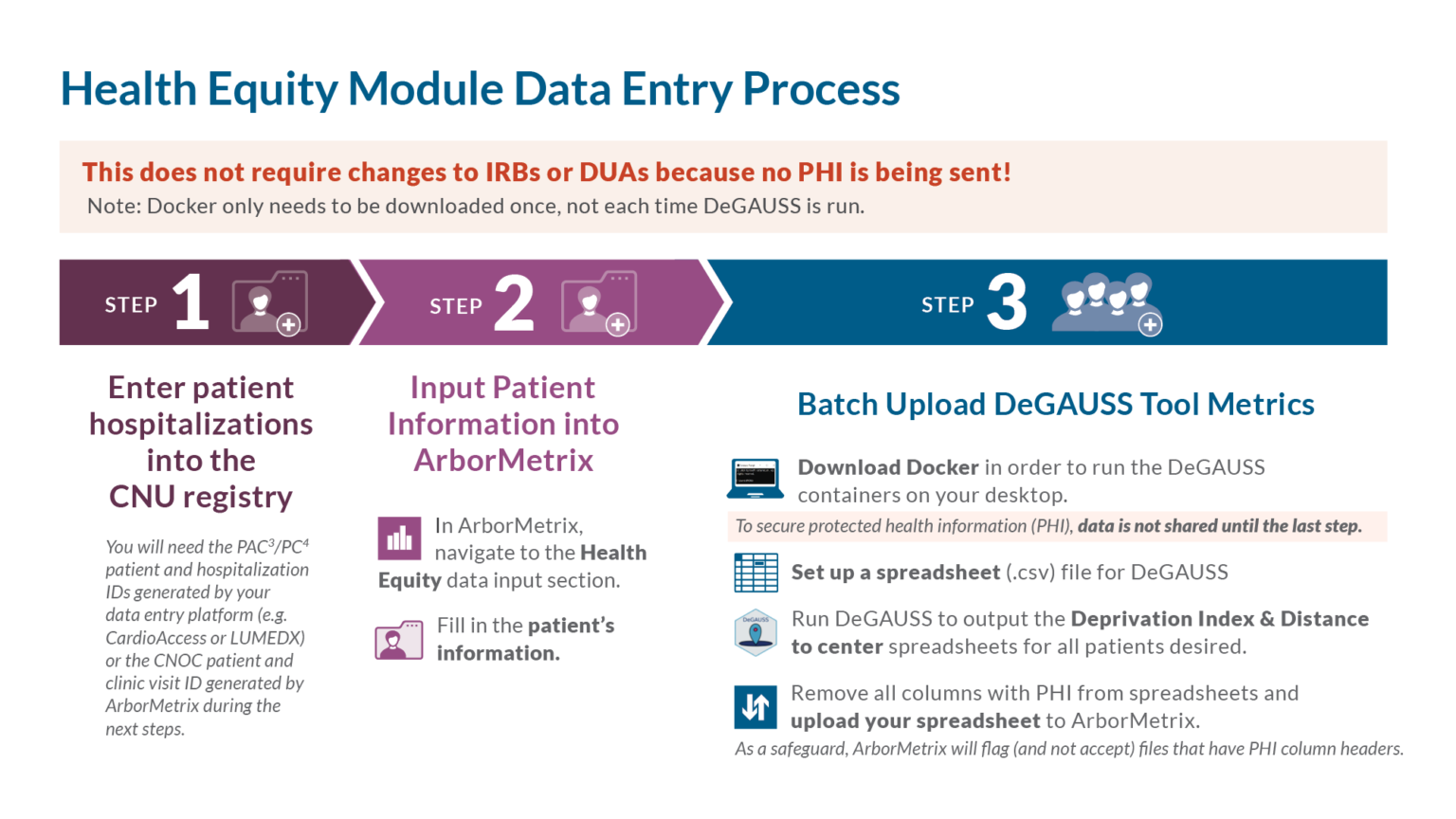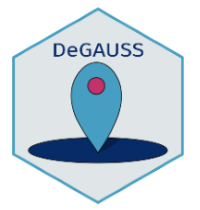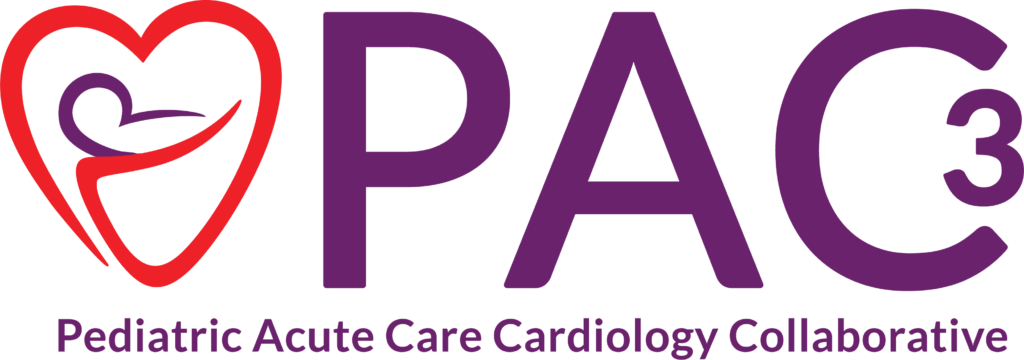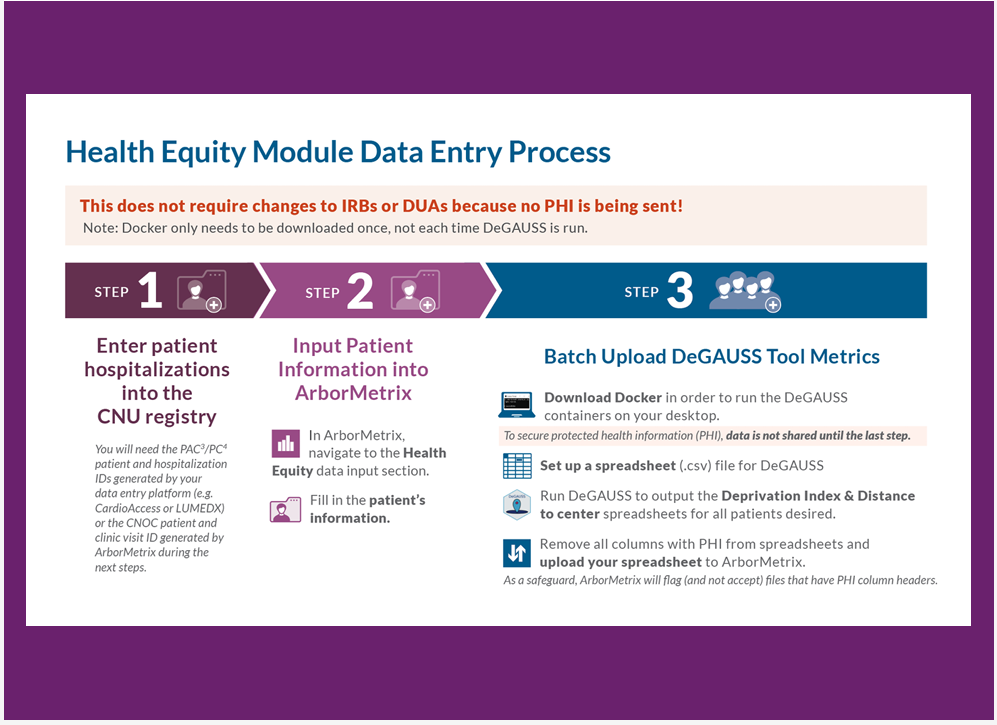Health Equity Module
Health Equity
Pediatric cardiology has made amazing progress over the last few decades. This is particularly true for children with congenital heart disease (CHD), with many improvements in patient survival.1 Despite these improvements, health disparities still exist among children with CHD. Health disparities are defined as “a particular type of health difference that is closely linked with social, economic, and/or environmental disadvantage.”2
Information on social, economic and other disadvantages that may impact health are often not collected in a standard way. This stops this information from being shared in ways that help large research investigations understand disparities in rare conditions such as CHD. Knowing where a child lives, and their associated social, economic, and physical background could inform efforts to identify and address disparities in health outcomes.
The Decentralized Geomarker Assessment for Multi-site Studies (DeGAUSS) tool gives investigators the ability to gain information about where a patient lives without directly exchanging protected health information (PHI) across institutions.3,4 DeGAUSS capabilities provide an opportunity for multicenter collaboratives, like the Pediatric Acute Care Cardiology Collaborative (PAC3), to strengthen approaches to identifying and responding to disparities. We aim to develop a health equity module that incorporates information on relevant social determinants of health. This module could be integrated into multicenter efforts to identify and then eliminate inequities within subspecialty populations, like those with CHD.

 DeGAUSS is run on Docker, an open-source project for automating the deployment of applications as portable, self-sufficient containers that can run on the cloud or on-premises. Docker delivers the DeGAUSS images to your local computer. Once the DeGAUSS images are downloaded from Docker, patient addresses are run through the them without using the internet, ensuring protection of PHI.
DeGAUSS is run on Docker, an open-source project for automating the deployment of applications as portable, self-sufficient containers that can run on the cloud or on-premises. Docker delivers the DeGAUSS images to your local computer. Once the DeGAUSS images are downloaded from Docker, patient addresses are run through the them without using the internet, ensuring protection of PHI.
Use the directions on the DeGAUSS webpage to download Docker
For additional information, refer to the PAC3 Guide on the DeGAUSS website.
What is DeGAUSS and why does the PAC3 registry want to use it?
The DeGAUSS tool is a decentralized geocoding tool that was developed at the University of Cincinnati. It uses a container software called Docker and allows each member institution of PAC3 to extract information pertaining to socioeconomic disparities on each of their patients in the registry in a HIPAA-compliant manner. The tool allows centers to extract various variables that are referred to as “images” from national databases including the US Census and American Community Survey including deprivation index, distance to hospital from home, and air pollution. This allows hospitals to safely share demographic variables on multihospital registry projects without sharing any PHI such as a zip code.
You can read more about DeGAUSS on their homepage here.
You can read more about DeGAUSS images, which contain the actual demographic variables, here.
Can I watch a presentation or demo about DeGAUSS to better understand where it will fit in the framework of our registry work?
Yes! Dr. Cole Brokamp, the creator of this tool, presented at the Spring 2021 PAC3 Conference which you can see here. His presentation starts at 7:32. Erika Rasnick introduced DeGAUSS and how to run it in this VIDEO.
Our heart center IS person isn’t familiar with DeGAUSS. What information can we give them?
The software containers created for DeGAUSS are hosted in an online repository and Docker is used to download and run these; not unlike an R or python installation that utilizes packages from an online repository like CRAN. (For more information on Docker, see page 3)
Citations from publications are available on the website: https://degauss.org/
DeGAUSS is open-source federally funded software, and you can view the GNU General Public License here: https://github.com/degauss-org/geocoder/blob/master/LICENSE
This means that you cannot buy a license or purchase support for the software. The creator, Cole Brokamp, and his team are very responsive to all questions.
Who else has used the DeGAUSS tool?
Columbia University, Vanderbilt University, Cincinnati Children’s, Children’s Hospital of Philadelphia, Boston Children’s Hospital, Harvard University, Weill Cornell Medicine, Mayo Clinic, Northwestern University and many more. Check out other users here at the bottom of the page. https://degauss.org/index.html
How does the patient information get protected?
All data entered is never exposed to a third party or the internet. There is a build in fail-safe in the Health Equity module when uploading data to prevent any PHI to be delivered to the data registry. These items are identified by the headings on each .csv file.
My department approved the use of Docker and it’s been downloaded on my computer and I’m ready to go! How do I use DeGAUSS?
Read carefully about how to geocode here. Again, rules for Mac versus PC users will be a bit different.
You can also view a video of the PAC3 data manager running this tool using the geocoder image and the deprivation index image here. You can also access the video directly on Sharepoint by clicking on “Registry” on the left-hand side of the screen when you sign in and then click on the “DeGAUSS” folder.
Note that when you use the DeGAUSS tool, you MUST run your baseline spreadsheet with the hospitalization IDs (the same as PAC3/PC4 hospitalization IDs) and patient addresses through the geocoder image first to get census tract information before running it through the other images that have actual demographic information such as dep_index, drivetime, etc. The video demonstrates this.
I received an email saying the grace period for Docker is ending and we will have to start paying for it. Will this affect our ability to use DeGAUSS?
No. The charges are referring to for-profit organizations that want to create their own containers and host them using Docker Hub. The “Docker Desktop” software that you will be using to analyze data will always be free and open source. The charges are for the extra enterprise features that they are now advertising. You can get this free version by going to https://degauss.org/using_degauss.html and clicking on either “macOS” or “Windows” link in the first paragraph. Ultimately some organizations choose to purchase software which should be discussed with your department.
Is Docker paid for by PAC3 for participating centers?
See above.
I installed Docker and get a notification that says, “Docker Desktop – Access denied. You must be in the docker-users group.” How to I proceed?
It may be that you must be added to your hospital’s user list, which will be done through your IT/IS department.
Where will the Docker software be stored?
The Docker software is downloaded to the work computer of everyone in your department that will be using the software. Most of the time, it will be a PAC3 data champion and/or a data analyst or data manager within your department.
Docker works on all operating systems, but please note that directions for how to install the software and how to run DeGAUSS differ for Mac and PC users. Directions on how to install Docker are here.
Where can IT inquire about documentation and security for the Docker software to approve its use?
Please contact the Docker customer support web page here. If you scroll down to “Support & Documentation” and click on “Docker Docs” that page might have the documentation your IT is looking for. Otherwise, click on “Contact Support.” If additional questions please reach out to Gavin Durman (gavin.durman@cchmc.org) – an IT specialist at Cincinnati Children’s – or pac3@childrens.com
Quick Start Coding for DeGAUSS Compatible with Windows/PC User
There are additional resources for PAC³ Centers on SharePoint:
1 Bouma BJ, Mulder BJM. Changing Landscape of Congenital Heart Disease. Circulation Research. 2017;120(6):908-922. doi:10.1161/circresaha.116.309302
2 Disparities. U.S. Department of Health and Human Services. Updated 10/27/21. Accessed 12/08/2021, https://www.healthypeople.gov/2020/about/foundation-health-measures/Disparities
3 Brokamp C. DeGAUSS: Decentralized Geomarker Assessment for Multi-Site Studies. Journal of Open Source Software. 2018;3(30):812. doi:10.21105/joss.00812
4 Brokamp C, Wolfe C, Lingren T, Harley J, Ryan P. Decentralized and reproducible geocoding and characterization of community and environmental exposures for multisite studies. Journal of the American Medical Informatics Association. 2018;25(3):309-314. doi:10.1093/jamia/ocx128
Sponsored by the Pediatric Health Network


